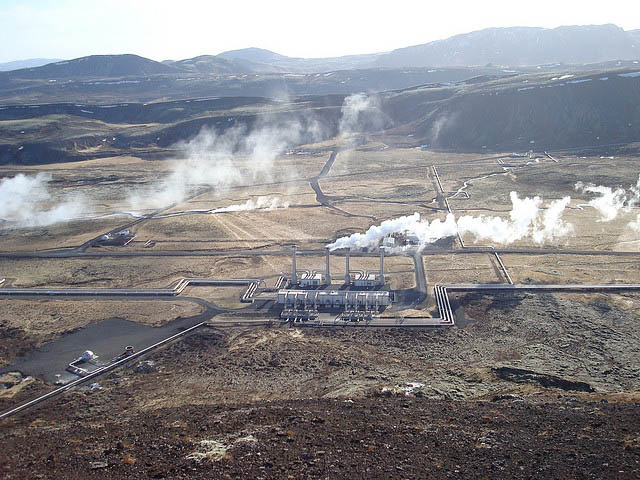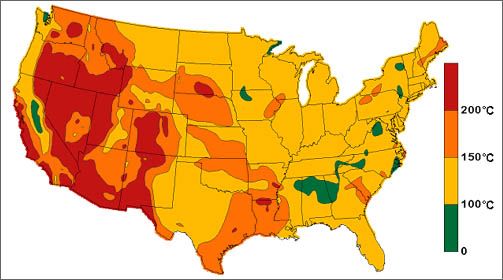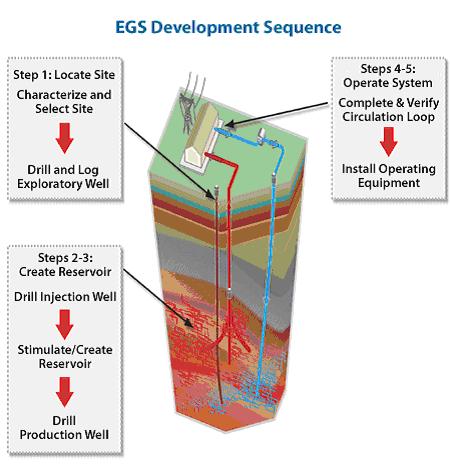Along with hydropower, geothermal power is an old form of renewable energy. The first geothermal power plant developed to generate electricity dates back to 1904, in Italy — though geothermal energy more broadly has been utilized in one way or another even longer. Though firmly established geothermal power doesn’t get the press, nor public mention, nor investment, as newer, flashier forms of renewable energy, such as solar power, wind power, or biofuels.
Nevertheless, geothermal power can, in the right places, be a very important part of a future low-carbon energy mix. Let’s take a look at how geothermal power is tapped to produce electricity, how much is being generated, and how much possibly could be generated with changes in technology currently being explored.

Some history and terminology
When people talk about geothermal power they may be talking about using the heat of the earth more or less directly for heat or cooling — as with a geothermal heat pump or, as is the case in Iceland, where the vast majority of buildings get their hot water supply from water heated by the Earth itself — or they may be talking about tapping into the heat generated inside the planet to generate electricity. Right now, we’ll be discussing geothermal electricity specifically, though the term geothermal power will be used most often.
As was said, the first commercial geothermal power plant was developed over a hundred years ago in Italy. Experimental power plants were developed in several countries over the next decade, but Italy remained the only nation generating electricity directly from the heat of the Earth until 1958, when New Zealand developed one, using a slightly different technology. Two years later, the first geothermal power plant was built in the United States, which is now has the world’s largest geothermal power capacity.
How does it work?
There are three types of geothermal power plants, defined at the most critical level by the temperature of geothermal resource they can use, all of which basically take water that has been heated deep within the Earth, that emerges as steam, and use it to turn a turbine and produce electricity.
Dry steam plants, the oldest design, takes the steam directly from a drilled well, turns the turbine, gets cooled in a compressor back into water, and then sends the cooled water back into the Earth via another well. These need temperatures of at least 150°C.
Flash steam plants, the most common type, need temperatures of 180°C or higher. In these highly pressurized hot water is extracted and fed into lower pressure tanks before being sent to turn the turbine.
Binary cycle plants can run at temperatures of just 57°C. Here the hot water, which is obviously well below the boiling point, is passed by a liquid that has a lower boiling point than water. This second liquid is the one that turns to steam, turning the turbine. Most new geothermal plants today use this technology.
Under development is a fourth geothermal power plant type, called in the US enhanced geothermal systems, that has the potential to radically expand how much electricity can be generated from geothermal energy, but that will get its own section farther along.
Regardless of the specific set-up, geothermal power has the decided advantage, compared to other renewable energy sources, that the power source is always on — the Earth is always heating. And though local depletion of the resource has to be managed, the amount of heat generated by the planet far exceeds the ability to extract it.
Though not a truly zero-carbon power source — there are some greenhouse gases that are generated in the process, as well as other environmental impacts to be managed — the average CO2 emissions from a geothermal power plant are just one-eighth those of a coal-fired power plant.
How much is being generated today?
There’s a bit over 10.7 gigawatts of geothermal electricity capacity in the world today, with roughly one third of that installed in the United States.
In total, 24 countries have at least one geothermal power plant. Geothermal provides over one-quarter of the electricity in the Philippines (which has the second-highest total amount of installed capacity), in El Salvador, and in Iceland (where 27% of the electricity comes from geothermal).
Nations where there’s over 100 megawatts of geothermal capacity, not already mentioned, include Indonesia (the third-highest amount at 1197 MW and vast potential, though under 5% of electricity used), Mexico, Italy, New Zealand, Japan, Kenya, and Costa Rica.
Coming back to the United States, California far and away leads the nation in geothermal capacity, with nearly 81% of the total. Nevada has slightly over 15%. Utah, Hawaii, Oregon, and Idaho all have some geothermal power plant, but each is under 1.5% of the nation’s total. Alaska and Wyoming, too, have some geothermal installed but each is under one-tenth of one percent of the total capacity. The Geothermal Energy Association notes that in addition to these states Arizona, Colorado, Montana, New Mexico, and Washington all have significant potential for either geothermal electricity for direct use of the the geothermal resource.
The map below gives you a rough overview of this, in the continental US, with the red and orange areas corresponding to the highest temperatures, the most potential.

According to info from the GEA, in the US, “up to 14 plants could become operational in 2013 and 9 new plants in 2014 and 10 more plants by 2015.” As Earthtechling’s Pete Danko points out this would result in an additional 600 MW of geothermal power in the US by 2016, more growth in the industry than has resulted in the previous eight years.
What’s the potential for geothermal power?
Like solar power and wind power, the potential of geothermal power is vast, in theory at least: At minimum 35 GW (a mere trebling of current capacity), at most 2,000 GW. Including all the resource going down to depths of 10,000 meters below the surface of the planet (which is about the depth of the deepest, and most expensive, wells ever dug), there’s 50,000 times more energy than all the oil and gas resources in the world, according to the Union of Concerned Scientists—but that’d be really pushing the technology from where it is today.
As for where the best quality, easiest access geothermal resources are, quoting again from UCS:
“The areas with the highest underground temperatures are in regions with active or geologically young volcanoes. These “hot spots” occur at plate boundaries or at places where the crust is thin enough to let the heat through. […] These regions are also seismically action. Earthquakes and magma movement break up the rock covering, allowing water to circulate. […] In addition, there is a vast amount of heat energy available from dry rock formations very deep below the surface (4-10 km). Using a set of emerging technologies known as enhanced geothermal systems (EGS), we may be able to capture this heat for electricity production on a much larger scale than conventional technologies allow.”
It’s using EGS technologies that allows UCS to say there’s 50,000 times the geothermal potential as all oil and natural gas. Using the three technologies deployed today, that’s the 35-2000 GW figure. It’s a significant amount, but not on the scale of the potential of wind or solar power — and, using current technology, it’s much more limited geographically.
Enhanced Geothermal Systems
Back in 2008, Google invested $10 million into research into enhanced geothermal systems, touting the technology:
“EGS expands the potential of geothermal energy by orders of magnitude. The traditional geothermal approach relies on finding naturally occurring pockets of steam and hot water. The EGS process, by comparison, replicates these conditions by fracturing hot rock, circulating water through the system, and using the resulting steam to produce electricity in a conventional turbine.”
The US Department of Energy has also invested significant sums to developing this technology, as have investors and governments in Australia, France, Germany and Japan.
The image below gives you a general idea of how the process works.

Beyond the not insignificant technical and financial problems in commercializing EGS, there’s some indication that EGS can trigger earthquakes, with a risk that “is similar to that associated with hydraulic fracturing.” Considering what more we’re learning about that risk, it is something to be taken seriously.
In fact, back in 2007, an EGS project in Switzerland was suspended after more than 10,000 seismic events, with quakes measuring up to 3.6 on the Richter scale, were trigger in just the fix six days of water being injected.
Even so, a report in Geoscience Australia says the risk “can be reduced by careful management and monitoring [and] should not be regarded as an impediment to further development.”
More on EGS: How an Enhanced Geothermal System Works